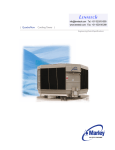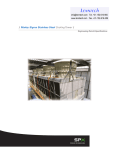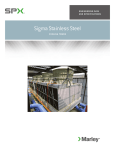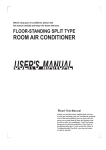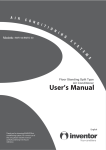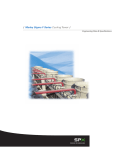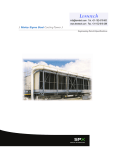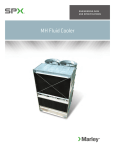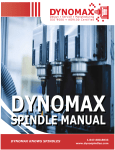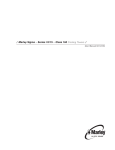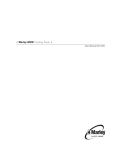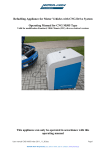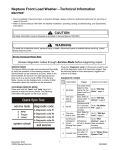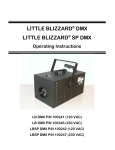Download Marley Quadraflow fiberglass cooling tower engineering data and
Transcript
E N G I N E E R I N G DATA A N D S P E C I F I CAT I O N S Marley Quadraflow® C O O L I N G TOW E R Quadraflow Cooling Tower — Contents 3 Engineering Data Schematic5 Support5 Environmental13 Application14 Freezing Weather Operation 15 Specifications / Base Base16 Thermal Performance 16 Performance Warranty 16 Construction17 Fill, Louvers and Drift Eliminators 18 19 Mechanical Equipment Hot Water Distribution System 20 20 Casing, Top Deck and Fan Cylinder Cold Water Collection Basin 20 Warranty21 Scope of Work 21 Specifications / Options Control Options Control System Vibration Limit Switch Basin Heater Variable Speed Drive 22 23 23 25 Quadraflow Cooling Tower — Engineering Data: Schematic The Marley QuadraFlow is a molded fiberglass, factory fabricated, field erected, general purpose crossflow cooling tower, designed to serve all normal cooling water systems—as well as those systems whose water quality would jeopardize the life expectancy of a galvanized cooling tower. In some locations, the quality of the circulating water is very poor. This can be because of the character of the makeup water (brackish, acidic, alkaline, etc.), or because of contamination by the product being cooled. In many cases, it is because of poor air quality at the site. Cooling towers being ideal air washers, the cooling tower water soon mimics the quality of the air. The left hand column of pages 15 thru 23 provides text for the various specification paragraphs, whereas the right hand column comments on the meaning of the subject matter and explains its value. 4 Pages 15 thru 20 indicate those paragraphs which will result in the purchase of a tower that will not only accomplish the specified thermal performance, but will include normal operation and maintenance enhancing features. Also on these pages are paragraphs intended to add those features and components that will customize the tower to meet the user's requirements. Space does not permit definition and explanation of all the possible options that can be applied to the QuadraFlow. We realize that you, the purchaser, must be happy with the tower and its characteristics, and we are prepared to provide—or provide for—any reasonable enhancement that you are willing to define and purchase. Your needs will become part of the continuing evolution of this Marley product line. Quadraflow Cooling Tower — Engineering Data: Schematic 5 W 21000 – 22000 – 23000 A INLET 6" MIN. A Model W PLAN Nominal Tons Dimensions Motor Inlet Outlet hp note 5 note 8 4 1⁄8" 5-15 8" 10" 2'-4 13⁄16" 4 1⁄8" 10-15 8" 10" 2'-10 1⁄8" 2'-4 13⁄16" 4 1⁄8" 10-20 8" 10" 8'-6 3⁄16" 2'-7 9⁄16" 2'-8 7⁄8" 7 1⁄8" 10-20 10" 12" 9'-10 1⁄2" 9'-10 3⁄8" 2'-7 9⁄16" 2'-8 7⁄8" 7 1⁄8" 15-40 10" 12" 16'-8 1⁄8" 9'-10 1⁄2" 9'-9 5⁄8" 3'-2 9⁄16" 2'-8 7⁄8" 8 15⁄16" 20-40 2 @ 8" 14" 16'-8 1⁄8" 11'-2 3⁄4" 11'-1 13⁄16" 3'-2 9⁄16" 2'-8 7⁄8" 8 15⁄16" 20-50 2 @ 8" 14" note 2 W H S A B C 21120 129-183 12'-8 1⁄8" 7'-1 3⁄4" 7'-2 3⁄8" 2'-10 1⁄8" 2'-4 13⁄16" 21220 186-211 12'-8 1⁄8" 8'5" 8'-5 9⁄16" 2'-10 1⁄8" 21320 204-256 12'-8 1⁄8" 9'-9 1⁄4" 9'-9 1⁄4" 22120 243-304 14'-0 5⁄8" 8'-6 1⁄4" 22220 312-425 14'-0 5⁄8" 23120 390-475 23220 419-548 MOTOR LOCATION MAKE UP NOTE 3 TOP OF FAN GUARD ACCESS COVER S H CL USE FOR STATIC LIFT B TOP OF SUPPORT BY OTHERS CL B CL 2'-6" MIN. C CL TOP OF SUPPORT COLLECTION BASIN DRAIN 2" DIA. OVERFLOW 4" DIA. ROOF OR GRADE CL OUTLET B ELEVATION Use this data for preliminary layouts only. Obtain current drawing from your Marley sales representative. Maximum Sump Capacities - gpm Outlet Diameter Model UPDATE ™ web-based selection software, available at spxcooling.com/update provides Quadraflow model recommendations based on customer's specific design requirements. OUTLET CL 6" 8" 10" 12" 14" 21000 440 770 22000 — 875 1215 — — 1400 2025 23000 — 960 — 1500 2180 2610 NOTE 1. Dimensions shown are for preliminary layout only. Obtain current engineering drawings or CAD files from your Marley sales representative for final layout. 2. Nominal tons are based upon 95°F HW, 85°F CW, 78°F WB, and 3 gpm/ton. 3. Makeup connection may be 1" or 2" diameter, depending upon tower heat load, water pressure, and desired connections. 4. All table data is per cell. 5. 21000 and 22000 models require only one inlet per cell and inlet piping may be located at any of the four tower corners. 23000 models whose design GPM is 2025 or less may use a single 10" inlet. Above 2025 GPM, two 8" inlets are required, located 180° apart. Subtract 2" from “S” dimensions. Locating inlet riser directly behind motor is not recommended due to restrictions placed on motor access and removal. 6. All piping loads must be supported independent of tower. 7. All piping and supports are by others. 8. Outlet diameters shown are for maximum GPM. Smaller outlet diameters may be appropriate. Quadraflow Cooling Tower — Engineering Data: Schematic 6 21000 – 22000 – 23000 W L G J F D E MIN A 1'-0" MIN A INLET INLET PLAN—TWO CELL PLAN—MULTICELL Two-cell installations may conform to either of the two schemes shown here. Choose the pattern that best fits into your available space. The multicell scheme shown here applies to any number of cells. Contact your Marley sales representative for additional details if you prefer to use the scheme at the left for an installation of three or more cells. Dimensions Model W L A D E F G J 21120 12'-8 ⁄8" 14'-1 ⁄4" 2'-10 ⁄8" 28'-8 ⁄4" 9'-0 ⁄4" 3'-4" 7'-0 ⁄8" 2'-1 9⁄16" 21220 12'-8 ⁄8" 14'-1 ⁄4" 2'-10 ⁄8" 29'-2 ⁄4" 9'-6 ⁄4" 3'-10" 7'-0 ⁄8" 2'-1 9⁄16" 21320 12'-8 ⁄8" 14'-1 ⁄4" 2'-10 ⁄8" 29'-7 ⁄4" 9'-11 ⁄4" 4'-3" 7'-0 ⁄8" 2'-1 9⁄16" 1'-10" 1 1 1 3 3 3 1 1 1 1 1 1 1 1 1 7 7 7 22120 14'-0 5⁄8" 16'-1 1⁄8" 2'-7 9⁄16" 32'-4 1⁄4" 9'-6 1⁄8" 4'-3" 8'-0 9⁄16" 22220 14'-0 5⁄8" 16'-1 1⁄8" 2'-7 9⁄16" 32'-10 1⁄4" 10'-0 1⁄8" 4'-9" 8'-0 9⁄16" 1'-10" 23120 16'-8 1⁄8" 18'-2 7⁄8" 3'-2 9⁄16" 38'-2 1⁄4" 11'-3 1⁄8" 4'-10" 9'-1 7⁄16" 1'-10 7⁄16" 23220 16'-8 1⁄8" 18'-2 7⁄8" 3'-2 9⁄16" 38'-7 1⁄4" 11'-8 1⁄8" 5'-3" 9'-1 7⁄16" 1'-10 7⁄16" Quadraflow Cooling Tower — Engineering Data: Schematic 7 24000 24'-6" 3'-11" 6" MIN Model Nominal Tons note 2 24120 24220 Dimensions Motor hp Inlet 9'-8 3⁄16" 15-60 2 @ 10" 13'0 ⁄16" 25-60 2 @ 10" H S 531-836 12'-8 1⁄2" 796-1047 16'-1" 11 MAKE UP NOTE 3 24'-6" ACCESS COVER CL INLET 3'-6 1/16" CL 3'-11" 1'-1 7/8" MOTOR SUMP PLAN TOP OF FAN CYLINDER OVERFLOW AND DRAIN 4" DIA. CL FACE OF SUMP OUTLET NOTE 9 CL 3'-6 1/16" Maximum Sump Capacities - gpm Outlet Diameter H S USE FOR STATIC LIFT CL TOP OF SUPPORTS BY OTHERS COLLECTION BASIN CL CL 3'-6 1/16" 1'-4 1/16" ROOF OR GRADE 2'-6" MIN. 8" 10" 12" 14" 1550 2450 3500 4250 For gravity flow applications, outlet piping must drop vertically out of tower a sufficient distance to overcome all head losses within outlet piping system. OUTLET SUMP DRAIN 1/2" DIA. ELEVATION NOTE 1 Dimensions shown are for preliminary layout only. Obtain current engineering drawings or CAD files from your Marley sales representative for final layout. 2 Nominal tons are based upon 95°F HW, 85°F CW, 78°F WB, and 3 gpm/ton. 3 Makeup connection may be 1" or 2" diameter, depending upon tower heat load, water pressure, and desired connections. 4 5 6 7 All table data is per cell. All piping loads must be supported independent of tower. All piping and supports are by others. Locating inlet riser directly behind motor is not recommended due to restrictions placed on motor access and removal. 8 Outlet sump may be installed rotated 90° or 180° provided outlet piping will clear tower support. Quadraflow Cooling Tower — Engineering Data: Schematic 8 24000 24'-6" 27'-5 9/16" 13'-813/16" 1'-11 3/8" 3'-11" D W 1'-0" MIN INLET INLET 3'-11" PLAN—TWO CELL Two-cell installations may conform to either of the two schemes shown here. Choose the pattern that best fits into your available space. Use this data for preliminary layouts only. Obtain current drawing from your Marley sales representative. UPDATE ™ web-based selection software, available at spxcooling.com/update provides Quadraflow model recommendations based on customer's specific design requirements. PLAN—MULTICELL The multicell scheme shown here applies to any number of cells. Contact your Marley sales representative for additional details if you prefer to use the scheme at the left for an installation of three or more cells. Model Dimensions D W 24120 4'-3" 53'-3" 24220 5'-8" 54'-8" Quadraflow Cooling Tower — Engineering Data: Support ANCHOR CL BOLT CL ANCHOR BOLT 21000 – 22000 – 23000 CL ANCHOR BOLT M P 9 ANCHOR CL BOLT P M Dimensions Model M Maximum Operating Wt./Cell lb P Wind / Seismic Loads lb Maximum Operating Load Max. Vertical Max. Horizontal at Anchor Reaction at Anchor Reaction at Anchor lb 21120 7'-7 1⁄2" 7'-1 1⁄2" 10715 2934 664 / 2790 671 / 2679 21220 7'-7 ⁄2" 7'-1 1⁄2" 11016 3009 959 / 3543 807 / 2754 21320 7'-7 1⁄2" 7'-1 1⁄2" 11358 3121 1331 / 4213 950 / 2840 22120 9'-0 1⁄8" 8'-6 1⁄8" 14400 3881 921 / 3499 906 / 3600 22220 9'-0 1⁄8" 8'-6 1⁄8" 15159 4264 1279 / 4496 1067 / 3790 23120 9'-4 5⁄8" 8'10 5⁄8" 22465 6040 1625 / 6045 1075 / 5616 23220 9'-4 5⁄8" 8'10 5⁄8" 23120 6245 1860 / 7347 1230 / 5780 1 SEE SUPPORT DETAIL. TYPICAL FOUR PLACES 4" MIN 2" 1" MIN CL 4" MIN 2" CL CL 1" MIN 2" 4" MIN CL CL BEAM 1" MIN 1" MIN CL 1" MIN 1" MIN CL 2" 4" MIN CL 1" MIN 1" MIN ANCHOR BOLT COLUMN ANCHOR BOLT BEAM SUPPORT DETAIL Beam support option. 4" by 4" minimum bearing area to be provided by others at each anchor bolt location. Beam may be rotated 90°. COLUMN SUPPORT DETAIL Column (pier) support option. 4" by 4" minimum bearing area to be provided by others at each anchor bolt location. NOTE 1 Dimensions and details shown are for preliminary layout only. Obtain current engineering drawings or CAD files from your Marley sales representative for final layout. 2 The base of each QuadraFlow tower consists of a grid of galvanized steel beams as part of the tower assembly. Minimal additional support is required at the anchor bolt locations. • Additional support, design, construction, plus anchor bolt hardware by others. • 5⁄8" diameter anchor bolts are required. Projection of anchor bolts is 2 1⁄2" maximum, 1 1⁄2" minimum. • Anchor points must be framed flush and level at top. Maximum beam deflection to be 1/360" of span, not to exceed 1⁄2" at anchor bolts. 3 Maximum operating weight occurs with basin full to overflow level. Actual operating weight varies with GPM and piping scheme. Operating water levels in excess of recommended levels can result in loads exceeding values shown. 4 Consult your Marley sales representative for additional instructions if tower is to be supported directly on vibration isolators. 5 Wind loads are based on 30 psf and are additive to operating loads. Reactions due to seismic loads are calculated on the basis of a 1g lateral load and are additive to operating loads. Quadraflow Cooling Tower — Engineering Data: Support 10 21000 – 22000 – 23000 R R 2 13/16" V CL ANCHOR BOLT CL ANCHOR BOLT CL ANCHOR BOLT ANCHOR CL BOLT CL ANCHOR BOLT ANCHOR CL BOLT M P R M P V ANCHOR CL BOLT ANCHOR CL BOLT R SEE SUPPORT DETAIL. TYPICAL FOUR PLACES ANCHOR CL BOLT CL ANCHOR BOLT T SUPPORT PLAN—TWO CELL SUPPORT PLAN—MULTICELL Dimensions Model M P R V T U 21120 7'-7 1⁄2" 7'-1 1⁄2" 5'-1 7⁄8" 10'-0 7⁄8" 8'-4 5⁄8" 4'-7 3⁄16" 21220 7'-7 1⁄2" 7'-1 1⁄2" 5'-1 7⁄8" 10'-0 7⁄8" 8'-10 5⁄8" 4'-7 3⁄8" 21320 7'-7 ⁄2" 7'-1 ⁄2" 5'-1 ⁄8" 10'-0 ⁄8" 9'-3 ⁄8" 4'-7 3⁄8" 22120 9'-0 ⁄8" 8'-6 ⁄8" 6'-1 ⁄8" 12'-0 ⁄4" 9'-3 ⁄8" 4'-7 1⁄16" 22220 9'-0 1⁄8" 8'-6 1⁄8" 6'-1 5⁄8" 12'-0 1⁄4" 9'-9 1⁄2" 4'-7 1⁄16" 23120 9'-4 5⁄8" 8'-10 5⁄8" 6'-4 13⁄16" 12'-6 5⁄8" 12'-1 1⁄2" 6'-2 7⁄16" 23220 9'-4 5⁄8" 8'-10 5⁄8" 6'-4 13⁄16" 12'-6 5⁄8" 12'-6 1⁄2" 6'-2 7⁄16" 1 1 1 1 7 5 7 1 5 5 U MIN Quadraflow Cooling Tower — Engineering Data: Support M ANCHOR CL CL BOLT 24000 4'-5 1/4" CL CL ANCHOR BOLT CL CL ANCHOR BOLT P 11 4'-5 1/4" Dimensions Model P Wind / Seismic Loads lb Maximum Operating Wt./Cell lb Maximum Operating Load at Anchor lb Max. Vert. Reaction at Anchor Max. Horiz. Reaction at Anchor M P 24121 – 24127 14'-1 1⁄8" 13'-7 1⁄8" 48825 7355 4090 / 14844 1330 / 5852 24221 – 24225 14'-1 1⁄8" 13'-7 1⁄8" 48845 7610 7800 / 19809 1815 / 6105 ANCHOR CL CL BOLT M 4'-5 1/4" SEE SUPPORT DETAIL. TYPICAL 12 PLACES 4" MIN 2" 1" MIN CL 4" MIN 2" CL CL 1" MIN 2" 4" MIN CL CL BEAM 1" MIN 1" MIN CL 1" MIN 1" MIN CL 2" 4" MIN CL 1" MIN 1" MIN ANCHOR BOLT BEAM SUPPORT DETAIL Beam support option. 4" by 4" minimum bearing area to be provided by others at each anchor bolt location. Beam may be rotated 90°. ANCHOR BOLT COLUMN COLUMN SUPPORT DETAIL Column (pier) support option. 4" by 4" minimum bearing area to be provided by others at each anchor bolt location. NOTE 1 Dimensions and details shown are for preliminary layout only. Obtain current engineering drawings or CAD files from your Marley sales representative for final layout. 2 The base of each QuadraFlow tower consists of a grid of galvanized steel beams as part of the tower assembly. Minimal additional support is required at the anchor bolt locations. • Additional support, design, construction, plus anchor bolt hardware by others. • 5⁄8" diameter anchor bolts are required. Projection of anchor bolts is 2 ¹⁄2" maximum, 1¹⁄2" minimum. • Anchor points must be framed flush and level at top. Maximum beam deflection to be 1/360" of span, not to exceed 1⁄2" at anchor bolts. 3 Maximum operating weight occurs with basin full to overflow level. Actual operating weight varies with GPM and piping scheme. Operating water levels in excess of recommended levels can result in loads exceeding values shown. 4 Consult your Marley sales representative for additional instructions if tower is to be supported directly on vibration isolators. 5Wind loads are based on 30 psf and are additive to operating loads. Reactions due to seismic loads are calculated on the basis of a 1g lateral load and are additive to operating loads. Quadraflow Cooling Tower — Engineering Data: Support 12 24000 3'-3 1/16" M 4'-5 1/4" CL CL ANCHOR BOLT P R R 3'-3 1/16" 6'-3 5/16" 2 13/16" CL CL ANCHOR BOLT 3'-0 1/4" 3'-3 1/16" CL CL CL CL ANCHOR BOLT ANCHOR CL CL BOLT ANCHOR CL CL BOLT CL ANCHOR BOLT 4'-5 1/4" S CL CL ANCHOR BOLT ANCHOR CL CL BOLT M CL P 4'-5 1/4" 2'-3 3/16" MIN T CL SEE SUPPORT DETAIL. TYPICAL 12 PLACES SUPPORT PLAN—TWO CELL Model R SUPPORT PLAN—MULTICELL Dimensions M P R S T 24120 14'-1 1⁄8" 13'-7 1⁄8" 6'-8 1⁄2" 19'-1 1⁄4" 6'-1 3⁄8" 24220 14'-1 1⁄8" 13'-7 1⁄8" 6'-8 1⁄2" 19'-1 1⁄4" 7'-6 3⁄8" 3'-3 1/16" R Quadraflow Cooling Tower — Engineering Data: Environment Sound Control Sound produced by a QuadraFlow tower operating in an unobstructed environment will meet all but the most restrictive noise limitations—and will react favorably to natural attenuation. Where the tower has been sized to operate within an enclosure, the enclosure itself will have a damping effect on sound. Sound also declines with distance— by about 5 dBA each time the distance doubles. Where noise at a critical point is likely to exceed an acceptable limit, several options are available—listed below in ascending order of cost impact: • In many cases, noise concerns are limited to nighttime, when ambient noise levels are lower and neighbors are trying to sleep. You can usually resolve these situations by using twospeed motors in either 1800/900 or 1800/1200 RPM configuration—operating the fans at reduced speed without cycling “after hours”. The natural nighttime reduction in wet-bulb temperature makes this a very feasible solution in most areas of the world, but the need to avoid cycling may cause the cold water temperature to vary significantly. 13 As suggested in the aforementioned Technical Report, it may also be advisable to specify a design wet-bulb temperature 1°F higher than normal to compensate for potential recirculation initiated by the enclosure. You’ll benefit from discussing your project with your Marley sales representative. System Cleanliness Cooling towers are very effective air washers. Atmospheric dust able to pass through the relatively small louver openings will enter the circulating water system. Increased concentrations can intensify system maintenance by clogging screens and strainers—and smaller particulates can coat system heat transfer surfaces. In areas of low flow velocity—such as the cold water basin—sedimentary deposits can provide a breeding ground for bacteria. In areas prone to dust and sedimentation, you should consider installing some means for keeping the cold water basin clean. Typical devices include side stream filters and a variety of filtration media. Water Treatment • The Marley Variable Speed Drive automatically minimize the tower’s noise level during periods of reduced load and/or reduced ambient temperature without sacrificing the system’s ability to maintain a constant cold water temperature. This is a relatively inexpensive solution, and can pay for itself quickly in reduced energy costs. • Where noise is a concern at all times—for example, near a hospital—the best solution is to oversize the tower so it can operate continuously at reduced (1200 or 900 RPM) motor speed. Typical sound reductions are 7 dBA at 2⁄3 fan speed or 10 dBA at 1⁄2 fan speed. • Extreme cases may require inlet and discharge sound attenuator sections—however, the static pressure loss imposed by attenuators may necessitate an increase in tower size. This is the least desirable approach because of the significant cost impact—and because of the obstruction to normal maintenance procedures. Your Marley sales representative will help you meet your sound requirements. Enclosures Occasionally, cooling towers are located inside architectural enclosures for aesthetic reasons. Although QuadraFlow towers adapt well to enclosures, the designer must realize the potential impact of a poorly arranged enclosure on the tower’s performance and operation. The designer must take care to provide generous air inlet paths, and the tower’s fan cylinder discharge height should not be lower than the elevation of the top of the enclosure. Obtain a copy of Marley Technical Report #H-004 “External Influences on Cooling Tower Performance” from your Marley sales representative or download at spxcooling.com. To control the buildup of dissolved solids resulting from water evaporation, as well as airborne impurities and biological contaminants including Legionella, an effective consistent water treatment program is required. Simple blowdown may be adequate to control corrosion and scale, but biological contamination can only be controlled with biocides. An acceptable water treatment program must be compatible with the variety of materials incorporated in a cooling tower—ideally the pH of the circulating water should fall between 6.5 and 8.0. Batch feeding of chemicals directly into the cooling tower is not a good practice since localized damage to the tower is possible. Specific startup instructions and additional water quality recommendations can be found in the QuadraFlow User Manual which accompanies the tower and also is available from your local Marley sales representative. For complete water treatment recommendations, consult a competent, qualified water treatment supplier. CAUTION The cooling tower must be located at such distance and direction to avoid the possibility of contaminated discharge air being drawn into building fresh air intake ducts. The purchaser should obtain the services of a Licensed Professional Engineer or Registered Architect to certify that the location of the cooling tower is in compliance with applicable air pollution, fire and clean air codes. Quadraflow Cooling Tower — Engineering Data: Applications Typical Applications Although the QuadraFlow is a premium-value cooling tower targeted for those applications that demand a high degree of corrosion resistance—as well as an aesthetically pleasing appearance—it is routinely applied in virtually all normal systems requiring cold water for the dissipation of heat. Some common applications include: • Condenser water service for air conditioning and refrigeration systems. The QuadraFlow is especially adapt able to Free Cooling applications. • Jacket water cooling for engines and air compressors. • Chemical and industrial processes. 14 Applications Requiring Alternative Cooling Tower Selections Certain types of applications are incompatible with any cooling tower with PVC film fill—whether a QuadraFlow or a competitive tower of similar manufacture. PVC is subject to distortion in high water temperatures, and the narrow passages typical of film-type fill are easily clogged by turbid or debris-laden water. Some of the applications, which call for alternative tower designs are: •Water temperatures exceeding 125°F—adversely affect the service life and performance of normal PVC fill. •Ethylene glycol content—can plug fill passages as slime and algae accumulate to feed on the available organic materials. • Batch cooling. • Welder cooling. • Plastic industry processes. • Dairy, citrus, and other food industry processing where water contamination is not likely to occur. Marley Controls SPX Cooling Technologies understands the capabilities and limitations of cooling towers and offers control systems that will assure you the greatest benefit from your tower. Ranging in sophistication from standard fan starters and disconnects to Programmable Logic Controllers that work in conjunction with your building or process system, these controls provide excellent energy management. Ask for Marley Technical Report H-001-A “Cooling Tower Energy and Its Management”. For those of you who use your tower in the Free Cooling mode Marley Technical Report H-002 “The Application of Cooling Towers for Free Cooling”, these controls can help you maximize the amount of time during the year that your expensive-to-operate chiller does not have to be operated. All motor controls are factory tested before shipping. Temperature controllers are provided to adjust fan operation to cooling requirements. •Fatty acid content—found in processes such as soap and detergent manufacturing and some food processing—fatty acids pose a serious threat for plugging fill passages. •Particulate carry over—often found in steel mills and cement plants—can both cause fill plugging, and can build up to potentially damaging levels on tower structure. •Pulp carry over—typical of the paper industry and food processing where vacuum pumps or barometric condensers are used— causes fill plugging which may be intensified by algae. Alternative Selections In addition to the QuadraFlow, SPX Cooling Technologies offers a full scope of products in various designs and capacities to meet the special demands of specific applications. Corrosion Resistance •Stainless steel construction—Marley stainless steel towers are available in both crossflow and counterflow configurations to solve site-related problems. They offer maximum resistance to corrosion while meeting stringent building codes. PVC film-type fill. •Sigma™ Series—available in wood, fiberglass, HDG steel or stainless steel structure. Field-erected for medium to large projects. Available in a wide range of sizes. Efficient PVC film fill. Splash-Fill Towers •NC® Alpha—factory assembled splash fill cooling tower. Excellent in “dirty water” situations. Special Installation •MS Series—custom-designed to fit your concrete enclosure. PVC film-type fill and Marley industrial-quality internal components provide years of trouble-free service. Quadraflow Cooling Tower — Engineering Data: Freezing Weather Operation When the ambient air temperature falls below 32°F, the water in a cooling tower can freeze. Marley Technical Report #H-003 “Operating Cooling Towers in Freezing Weather” describes how to prevent freezing during operation. Ask your Marley sales representative for a copy. During shutdown, water collects in the cold water basin and may freeze solid. You can prevent freezing by adding heat to the water left in the tower—or, you can drain the tower and all exposed pipework at shutdown. Basin Heater kW Selection Ambient Temp ºF +30º Electric Basin Heaters An automatic basin water heater system is available, consisting of the following components: • +20º Stainless steel electric immersion heater(s) mounted on stainless steel plates on the floor of the collection basin. • NEMA 4 enclosure containing: +10º —Magnetic contactor to energize heater. —Transformer to convert power supply to 24 volts for control circuit. —Solid state circuit board for temperature and low-water cutoff. Enclosure may be mounted on the side of the tower. • Control probe in the collection basin to monitor water temperature and level. 0º With this type of system, water flows from an indoor tank, through the load system, and back to the tower, where it is cooled. The cooled water flows by gravity from the tower to the tank located in a heated space. At shutdown, all exposed water drains into the tank, where it is safe from freezing. Model Phase and Voltage 1/208 -20º -30º 1/480 3/208 3/240 3 3 22000 4.5 4.5 23000 6 6 24000 — 15 21000 6 6 22000 6 6 23000 9 9 24000 — 21 21000 7.5 7.5 22000 23000 9 — 12 12 — 2@15 21000 9 9 22000 — 23000 12 12 15 — 22000 23000 — — — 2@18 — 12 12 — — 15 2@9 24000 — 21000 — 2@9 2@21 (2) 2@21 15 22000 — — 18 18 23000 — — 2@12 2@12 24000 — 4@15 (2) 21000 — 15 22000 23000 24000 — — — — 3/480 9 — 24000 21000 -10º 1/240 21000 24000 Note: any exposed piping that is still filled with water at shutdown— including the makeup water line—should be electrically traced and insulated (by others). Indoor Storage Tank 15 18 2@12 2@12 — — 4@18 (2) Except where (2) is indicated, one set of controls will handle the required number of heaters. Where (2) is indicated, however, two sets of controls are required per cell. Quadraflow Cooling Tower — Specifications: Base Specifications 16 Specification Value 1.0Base: 1.1 Furnish and install an induced-draft, crossflow-type, field-erected, fiberglass and stainless steel cooling tower of _____ cell(s), as shown on plans. Cells shall be similar and equal in all respects to Marley QuadraFlow Model ________. 2.0 Thermal Performance: 2.1 The tower shall be capable of cooling _____ GPM of water from _____ °F to _____ °F at a design entering air wet-bulb temperature of _____ °F. The thermal performance rating shall be Certified by the Cooling Technology Institute. 3.0 Performance Warranty: 3.1 CTI Certification notwithstanding, the cooling tower manufacturer shall guarantee that the cooling tower supplied will meet the specified performance conditions when the tower is installed according to plan. If, because of a suspected thermal performance deficiency, the owner chooses to conduct an onsite thermal performance test under the supervision of a qualified, disinterested third party in accordance with CTI or ASME standards during the first year of operation; and if the tower fails to perform within the limits of test tolerance; then the cooling tower manufacturer will pay for the cost of the test and will make such corrections as are appropriate and agreeable to the owner to compensate for the performance deficiency. specification base establishes the type, configuration, base material, and ■ Your physical limitations of the cooling tower to be quoted. During the planning and layout stages of your project, you will have focused your attention on a cooling tower selection that fits your space allotment, and whose power usage is acceptable. Limitations on physical size and total operating horsepower avoid the introduction of unforeseen operational and site-related influences. Specifying the number of cells, and the maximum fan hp/cell will work to your advantage. Fans of induced draft towers are in the warm (non-freezing) leaving airstream of the tower. They accelerate the moist air upward to prevent recirculation from degrading the tower's thermal performance. In forced-draft towers, the reverse is true, and recirculation happens routinely. Crossflow towers have a spacious plenum between banks of fill for easy access to all of the tower's internal components. Counterflow towers (one manufacturer offers nothing else) provide only cramped and awkward access to the mechanical equipment, the drift eliminators, and the water distribution spray system—and the very small access door is up near the top of the tower! Certification means that the cooling tower has been tested under operat■ CTI ing conditions and found to perform as rated by the manufacturer under those circumstances. It assures the buyer that the tower is not intentionally or inadvertently undersized by the manufacturer. CTI certification alone is not sufficient to assure you that the cool■ However, ing tower will perform satisfactorily in your situation. Certification is established under relatively controlled conditions, and cooling towers seldom operate under such ideal circumstances. They are affected by nearby structures, machinery, enclosures, effluent from other sources, etc. Responsible and knowledgeable bidders will take such site-specific effects into consideration in selecting the cooling tower—but the specifier must insist by the written specification that the designer/manufacturer guarantee this “real world” performance. Any reluctance on the part of the bidder should cause you some concern. Quadraflow Cooling Tower — Specifications: Base Specifications 4.0 Construction: 4.1 The cold water basin, structural columns, hot water distribution basins, basin covers, top deck, fan cylinder, and access door shall be formed of inert fiber-reinforced polyester (FRP), either molded or pultruded. All hardware, with the exception of the supporting grillage, shall be fabricated of 300 series stainless steel. This shall include the mechanical equipment support structure, fan guards, and all bolts, nuts and fasteners used in the construction of the tower. Design criteria for the tower structure and anchorage shall be 30 psf (1.44 kPa) wind load. Tower anchorage shall also meet a 1g horizontal seismic load. 4.2 4.3 The tower shall be capable of withstanding water having a pH of 6.5 to 8.0; a chloride content (NaCl) up to 750 ppm; a sulfate content (SO4 ) up to 1200 ppm; a calcium content (CaCO3) up to 800 ppm; silica (SiO2) up to 150 ppm; and design hot water temperatures up to 125°F (51.7°C). The circulating water shall contain no oil, grease, fatty acids, or organic solvents. The specifications, as written, are intended to indicate those materials that will be capable of withstanding the above water quality in continuing service, as well as the loads described in paragraph 4.1. They are to be regarded as minimum requirements. Where component materials peculiar to individual tower designs are not specified, the manufacturers shall take the above water quality and load carrying capabilities into account in the selection of their materials of manufacture. 17 Specification Value ■ This combination of fiberglass and stainless steel provides complete protection against the degrading effects of corrosion. The molded shapes of the fiberglass also provide an architecturally pleasing appearance that is rare in a cooling tower. The listed design values give you assurance that the tower can be shipped, handled, constructed—and ultimately operated in a long term hostile environment. Section 1632 of the 1997 UBC, “Lateral Force on…Equipment Supported by Structures,” states that the anchorage for permanent equipment must resist the lateral seismic force. The structure for the equipment is not required to resist the seismic force unless failure represents a life hazard. Life hazard is dependent on location and the process supported. If you feel the need to have a compliant structure please consult SPX engineering. Except for those unusual operating situations where the circulating water may be so laden with suspended solids, algae, fatty acids, product fibers, active organisms reflected in BOD, and the like that plugging of the fill is a probability, reasonable attention to the construction materials and/or their coatings is all that is normally required. If extended longevity of the tower is required—or unusually harsh operating conditions are expected—consider specifying 316 stainless steel components. Discuss the need for this with your local Marley sales representative. Quadraflow Cooling Tower — Specifications: Base Specifications 18 Specification Value 5.0 Fill, Louvers and Drift Eliminators: 5.1 Fill shall be film-type, thermoformed PVC, with louvers and eliminators formed as part of each fill sheet. Fill shall be suspended from stainless steel structural tubing supported from the tower structure and intermediate stainless steel panels, and shall be elevated at least 2" (51mm) above the floor of the cold water basin to facilitate cleaning. Air inlet faces of the tower shall be free of water splash-out. ■L ouvers integral with the fill keep the flowing water within the confines of the fill. The separate external louvers used by others permit water to escape the fill and form ice or produce an unsightly situation adjacent to the tower. If you plan to use your tower in the wintertime, particularly for free cooling, integral louvers will put your operating concerns to rest. Drift eliminators shall be PVC, triple-pass, and shall limit drift losses to 0.005% or less of the design water flow rate. ■D rift rate varies with design water loading and air rate, as well as drift eliminator depth and number of directional changes. A drift rate of 0.001% is readily available on many standard models. If a lower rate is required, please discuss with your Marley sales representative. 5.2 Drift Eliminators Louvers Fill sheets Quadraflow Cooling Tower — Specifications: Base Specifications 6.0 Mechanical Equipment: 6.1 Fan(s) shall be propeller-type, incorporating heavy-duty blades of cast aluminum or high-strength, inert composite material. Fan blades shall be individually adjustable and replaceable. Fan(s) shall be driven through a rightangle, industrial-duty, oillubricated, geared speed reducer that requires no oil changes for the first five (5) years of operation. Speed reducers employing pulleys and belts will not be permitted. 6.2 6.3 Motor(s) shall be ____ hp maximum, TEFC, 1.15 service factor, and specially insulated for cooling tower duty. Speed and electrical characteristics shall be 1800 (1800/900) RPM, single-winding, ___ phase, ____ hertz, ____ volts. Motor shall be located outside the humid interior of the tower, within an alcove in the tower's corner structure. The motor shall be connected to the geared speed reducer by a tubular stainless steel driveshaft equipped with neoprene flexible coupling elements. A neoprene oil gauge and drain line shall extend from the gear reducer to the motor enclosure, and shall be equipped with an easily visible oil sight glass. The mechanical equipment for each cell shall rest on a rigid stainless steel box-beam assembly that resists misalignment between the motor and the gear reducer. 19 Specification Value ropeller-type fans require only half the operating hp of blower-type fans. ■P However, they should be readily adjustable to permit compensation for jobsite conditions that may tend to overload the motor. Standard fan drives of other manufacturers may use V-belts. Considering the size of fans involved—and the hp applied—this is not good design practice. Gear drive is far more reliable and trouble free—and is not proprietary. It is currently offered as an additional cost option by principal Marley competitors. To reduce cost, some manufacturers may use TEAO motors, whose only source of cooling is the flow of air produced by the cooling tower fan. They are sometimes applied at hp significantly beyond their nameplate rating. Also, if they drive the fan through V-belts, they are probably mounted in a shaft-vertical position. This is not good practice in the moisture-laden airstream of a cooling tower because of the tendency of moisture to invade bearings by flowing down the motor shaft. Unless otherwise specified, motor speed will be 1800 RPM in 60 Hertz areas and 1500 RPM in 50 Hertz areas. If you prefer the operating flexibility of twospeed operation, please specify the RPM to be 1800/900 (1500/750 in 50 Hertz regions). Incidentally, two speed motors are a far better choice than separate “pony” motors which simply double the problems indicated above. The value of a 5 year mechanical equipment warranty speaks for itself. Except for the motor, all of the mechanical equipment on a Marley tower is made by SPX Cooling Technologies. Cooling tower vendors who purchase commercial fans, gear reducers, driveshafts, etc. may require that you deal directly with those commercial suppliers for warranty satisfaction. Quadraflow Cooling Tower — Specifications: Base Specifications 7.0 Hot Water Distribution System: 7.1 An FRP distribution basin shall receive hot water piped to each cell of the tower. Each basin shall include one or more inlet holes and grommets to accommodate appropriately sized inlet piping. Removable, interchangeable polypropylene nozzles installed in the floor of these basins shall provide full coverage of the fill by gravity flow. The hot water basin shall be covered by removable FRP covers that keep out sunlight and give a finished appearance to the tower. 8.0 Casing, Top Deck and Fan Cylinder: 8.1 Tower corner casings, top deck and fan cylinder shall be fabricated of molded FRP. Fan cylinders less than 60" (1524 mm) in height shall be equipped with a conical, non-sagging, removable fan guard, fabricated of welded 5⁄16" (8 mm) and 7 gauge stainless steel rods. 9.0 Cold Water Collection Basin: 9.1 The cold water basin shall be molded of FRP and sealed watertight. It shall include a float-operated makeup valve, a 4" (102 mm) diameter overflow connection, and a depressed FRP sump complete with a stainless steel debris screen. The top of the basin to the base of the fill shall be covered with removable, heavy gauge stainless steel screens to keep airborne leaves and debris out of the circulating water system. 9.2: The basin design shall allow for the installation of warm water bypass lines, as well as basin water level equalization lines between towers, if necessary. The cooling tower manufacturer shall provide drawings to facilitate the installation of these features by others. 9.3 The cold water basin and tower shall be supported by a structural beam assembly of welded sections, provided and installed by the cooling tower manufacturer. The assembly sections shall be hot-dip galvanized after fabrication. 20 Specification Value ■ Gravity-flow distribution basins are a feature of crossflow type towers, resulting in operating pump heads of from 10 to 20 feet less than that encountered in counterflow towers, with their pressurized spray systems. Also, these basins are out where they can be easily inspected—even maintained—while the tower is in operation. Spray systems of counterflow towers, sandwiched between the top of the fill and the drift eliminators, are extremely awkward to access and maintain. ■ Marley Models 21000 thru 23000 are equipped with the fan guard specified. 24000 Models have 5'-0" high, flared, velocity-recovery fan cylinders. ■ Everything within the basin is of inert, noncorroding material. Fiberglass towers can require very complicated support systems. To avoid errors in design and fabrication, the steel in immediate support of the basin should be provided by the cooling tower manufacturer. This should simplify the foundation requirements such that primary support can be accomplished by piers, if desired. Not being in contact with the cooling tower water, the supports need not be stainless steel, but they should be hot dip galvanized after fabrication. Quadraflow Cooling Tower — Specifications: Base Specifications 21 Specification Value 10.0Warranty: 10.1 The manufacturer shall warrant the entire tower against failure in normal operation for a period of five (5) years following shipment to the site. 11.0 Scope of Work: 11.1 The cooling tower manufacturer shall be responsible for the design, fabrication, and delivery of materials to the project site, and for the erection of the tower over primary supports provided at the proper elevation by others. Unless otherwise specified, all piping, pumps, controls, and electrical wiring will be outside the cooling tower manufacturer's scope of work. ■ A tower that is capable of meeting these specifications should easily be warrantable for five years. Please insist upon it! And, insist that the warranty cover all the tower, including the motor, gear reducer, (V-belts, if you allow them), and all other pieces of mechanical equipment. ■ T o assure proper fit-up of parts, and alignment of mechanical equipment, it is recommended that erection be made a part of the cooling tower manufacturer's contract. In any case, a comprehensive, illustrated Marley assembly manual will be provided which pictorially identifies the tower components—and provides step-by-step instructions designed to result in a correctly assembled tower. Quadraflow Cooling Tower — Specifications: Options Specifications Control Options Control System: 6.4 Add the following paragraph in the Mechanical Equipment section: Each cell of the cooling tower shall be equipped with a UL listed control system in a NEMA 3R or 4X outdoor enclosure capable of controlling single-speed or twospeed motors as required, and designed specifically for cooling tower applications. The panel shall include a main fused disconnect with an external operating handle, lockable in the off position for safety. Across-the-line magnetic starters or solid state soft-start starters as required shall be controlled with a thermostatic or solid state temperature controller. Door mounted selector switches shall be provided to enable automatic or manual control and wired for 120VAC control. Control circuit to be wired out to terminal blocks for field connection to a remote vibration switch and for access to extra 120VAC 50VA control power, overload trip alarms and remote temperature control devices. The temperature controller shall be adjustable for the required cold water temperature. If a thermostatic controller is used it shall be mounted on the side of the tower with the temperature sensing bulb installed in the cold water basin using a suspension mounting bracket. If a solid state temperature controller is used the controller will be door mounted on the control panel. The temperature controller will display two temperatures, one for outgoing water and the other for set point. Water temperature input shall be obtained using a three-wire RTD with dry well in the outlet water piping and wired back to the solid state temperature controller in the control panel. 22 Specification Value ■ I f it is your opinion that the control system for the cooling tower should be part of the tower manufacturer’s responsibility, we are in wholehearted agreement with you. Who better to determine the most efficient mode and manner of a tower’s operation—and to apply a system most compatible with it—than the designer and manufacturer of the cooling tower? Marley variable speed drives are also available for the ultimate in temperature control, energy management, and mechanical equipment longevity. Quadraflow Cooling Tower — Specifications: Options Specifications Vibration Limit Switch: 6.5 Add the following paragraph in the Mechanical Equipment section: A singlepole, double-throw vibration limit switch in a NEMA 4 housing shall be installed on the mechanical equipment support for wiring into the owner’s control panel. The purpose of this switch will be to interrupt power to the motor in the event of excessive vibration. It shall be adjustable for sensitivity, and shall require manual reset. Basin Heater: 9.4 Add the following paragraph in the Cold Water Basin section: Provide a system of electric immersion heaters and controls for each cell of the tower to prevent freezing of water in the collection basin during periods of winter shutdown. The system shall consist of a three-element, stainless steel, electric immersion heater welded to a 3/16" thick stainless steel mounting plate, complete with a NEMA 4 terminal box. A NEMA 4 enclosure shall house a magnetic contactor to energize heaters; a transformer to provide 24 volt control circuit power; and a solid state circuit board for temperature and low water cutoff. A control probe shall be located in the basin to monitor water level and temperature. The system shall be capable of maintaining 40°F water temperature at an ambient air temperature of ____ °F. Fan Motor Variable Speed Drive: ACH550 VFD System 6.4 Add the following paragraph in the Mechanical Equipment section when VFD is used with customers Building Management System: For fan control a complete UL listed variable speed drive system in a NEMA 1 indoor, NEMA 12 indoor or NEMA 3R outdoor enclosure shall be provided. The VFD shall use PWM technology with IGBT switching. VFD output switching signal shall be programmed to not cause mechanical vibration issues with backlash in gearbox teeth or vibration issues associated with long driveshafts. The VFD shall be programmed for variable torque applica- 23 Specification Value ■ Unless specified otherwise, a Marley M-5 vibration switch will be provided. The requirement for manual reset assures that the cooling tower will be visited to determine the cause of excessive vibration. ■ The basin heater components described at left represent our recommendation for a reliable automatic system for the prevention of basin freezing. They are designed for installation at the jobsite. Submerged in basin water, in which zinc ions are present, copper immersion heaters must not be used. Insist upon stainless steel. The ambient air temperature that you insert in the specifications should be the lowest 1% level of winter temperature prevalent at site. ■ Marley VFD drive systems are designed to combine absolute temperature control with ideal energy management. The cooling tower user selects a cold water temperature and the drive system will vary the fan speed to maintain that temperature. Precise temperature control is accomplished with far less stress to the mechanical equipment components. The improved energy management provides fast payback. Indeed, many utilities offer generous rebates for users having installed VFD drives. Quadraflow Cooling Tower — Specifications: Options Specifications tions and shall catch a fan spinning in the forward or reverse direction without tripping. VFD panel construction shall include a main disconnect with short circuit and thermal overload protection with external operating handle, lockable in the off position for lock-out tag-out safety procedures. A service switch directly ahead of the VFD shall be provided for voltage isolation during VFD maintenance. An integrated full voltage non-reversing bypass starter shall be furnished allowing fan motor operation if VFD has failed. The VFD system shall receive a speed reference signal from the building management system monitoring the cooling tower cold-water temperature. As an option to receiving the speed reference signal from a building management system, the drive must have the capability to receive a 4-20 mA temperature signal from an RTD transmitter. When using an RTD for temperature monitoring and speed control the VFD shall have an internal PI regulator to modulate fan speed maintaining set point temperature. The drive’s panel shall display the set-point temperature and cold-water temperature on two separate lines. The bypass shall include a complete electromechanical magnetic bypass circuit with the capability to isolate the VFD when in the bypass mode. Transfer to the bypass mode shall be manual in the event of VFD failure. Once the motor is transferred to the bypass circuit the fan motor will run at constant full speed. Operator controls shall be mounted on the front of the enclosure and shall consist of Start and Stop control, Bypass/VFD selection, Auto/ Manual selections and manual speed control. To prevent heating problems in the fan motor the VFD system shall de energize the motor once 25% motor speed is reached and cooling is no longer required. The manufacturer shall supply VFD start-up assistance by a certified technician. Specification Value 24 Quadraflow Cooling Tower — Specifications: Options Specifications Marley Premium VFD System: 6.4 Add the following paragraph in the Mechanical Equipment section when VFD is used as a stand alone system: For fan control a complete UL listed variable speed drive system in a NEMA 12 indoor or NEMA 3R outdoor enclosure shall be provided. The VFD shall use PWM technology with IGBT switching. VFD output switching signal shall be programmed as not to cause mechanical vibration issues with back lash in gearbox teeth or vibration issues associated with long drive shafts. VFD shall be programmed for variable torque application. The VFD shall catch a fan spinning in the forward or reverse direction without tripping. VFD panel construction shall include a main disconnect with short circuit and thermal overload protection with external operating handle, lockable in the off position for lock-out tag-out safety procedures. A service switch directly ahead of the VFD shall be provided for voltage isolation during VFD maintenance. An integrated full voltage non-reversing bypass starter shall be furnished allowing fan motor operation if VFD has failed. In the event of a system fault the VFD program logic shall evaluate type of fault determining if safe to automatically transfer fan motor to the bypass starter. Automatic bypass with an earth ground condition shall not be allowed. Once in bypass mode the internal controls will continue to monitor cold water temperature and cycle the fan motor on and off maintaining coldwater set point temperature. The drive system shall be designed and operated as a stand-alone system without the need for a BMS system. Operator controls shall be mounted on the front of the enclosure and shall consist of Start and Stop control, Bypass/VFD selector switch, Auto/Manual selector switch, Manual speed control, and solid-state temperature controller. An emergency bypass starter selector switch internal to the panel allowing the fan motor to be run at full speed shall be furnished. The system shall include a solid state Specification Value 25 Quadraflow Cooling Tower — Specifications: Options Specifications PI temperature controller to adjust frequency output of the drive in response to the tower cold-water temperature. A four-wire RTD with dry well shall be furnished with the VFD and field installed into the cold-water discharge pipe. The temperature of the coldwater and set point shall be displayed on the door of the control panel. The bypass starter shall be integrated into the same enclosure as the VFD including complete circuitry to isolate the VFD when in the bypass mode. To prevent heating problems in the fan motor the VFD system shall de-energize the motor once 25% motor speed is reached and cooling is no longer required. The VFD shall include deicing logic and manual control with the ability to reverse fan rotation including auto canceling with adjustable time. Speed in deice mode shall not exceed 50% motor speed. The manufacturer shall supply VFD start-up assistance by a certified technician. Specification Value 26 Quadraflow cooling tower E N G I N E E R I N G DATA A N D S P E C I F I CAT I O N S S PX C O O L I N G T E C H N O LO G I E S , I N C . 7401 WEST 129 STREET OVERLAND PARK, KANSAS 66213 USA P: 913 664 7400 F: 913 664 7439 [email protected] spxcooling.com In the interest of technological progress, all products are subject to design and/or material change without notice ISSUED 06/2013 QF-TS-13 COPYRIGHT © 2013 SPX Corporation




























